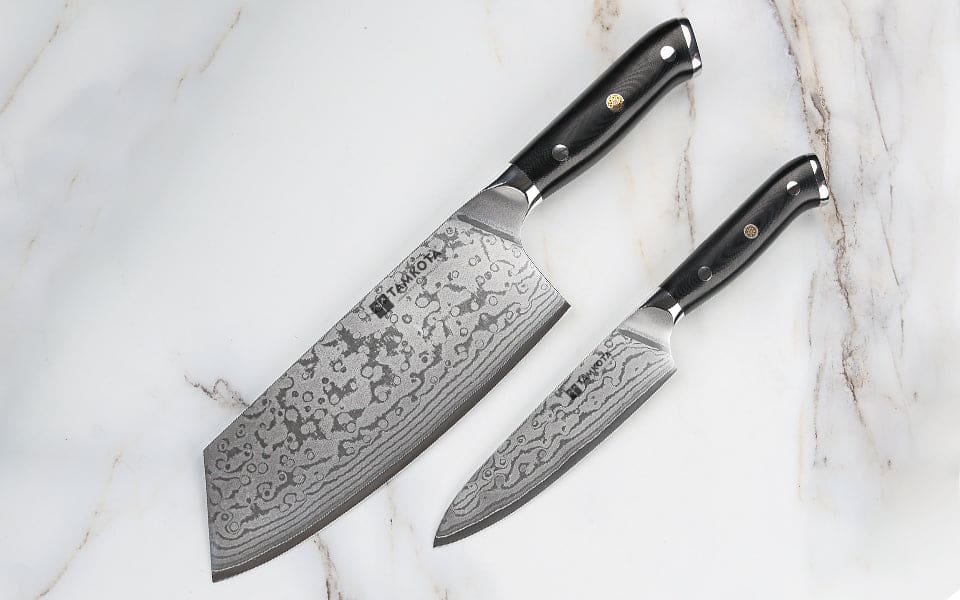
If you’re looking to get a new kitchen knife, then you should look into some of the different kinds of steel that are available. For instance, you can go with a VG-10 Damascus blade, or you can go with something called Cru-Wear.
CPM-S35VN
CPM-S35VN is a high-end martensitic stainless steel that has improved toughness over CPM-S30V. It is a great choice for knives because of its impact and abrasion resistance. The higher the carbon content of a steel, the more wear-resistant it is.
S35VN steel is also known to be relatively easy to machine and polish. However, the hardness of the steel will depend on how the blade is treated. Typically, the Rockwell Hardness rating of the steel ranges between 58 and 61.
It is also worth noting that there are a variety of alloys specifically designed for use in knives. Some examples are VG-10, Aogami, and ZDP-189. They are often used by manufacturers, such as Spyderco, Kershaw, and Henckels, to produce production knives.
S35VN is a high-carbon steel that contains a large amount of Vanadium. Vanadium helps improve the metal’s corrosion and wear resistance. Other metals, such as copper and tantalum, can also be added to a steel’s alloy.
VG-10 Damascus
Japanese knives, especially the chef’s knife, have special steel called VG10. This is a very high carbon stainless steel that is tough, rust resistant, and easy to sharpen.
VG10 is a type of stainless steel that is produced by Takefu Special Steel Corporation in Fukui, Japan. Besides its exceptional strength and toughness, it is also known for its corrosion resistance.
The Japanese steel is very hard and durable, and the combination of other steel additions, such as manganese and cobalt, makes it extremely tough. But it is not as forgiving as softer kinds of steel.
VG10’s hardness allows it to retain an edge for a long time. It is a machinable material, so it is simple to sharpen. However, it is more prone to pitting corrosion than other types of stainless steel. Therefore, it is important to regularly check for rust and polish it to keep it in good shape.
CTS-XHP
The CTS-XHP steel is a high-end stainless steel that has a combination of features that make it perfect for knives. It has excellent corrosion resistance, high edge retention, and good wear resistance.
One of the best things about CTS-XHP is that it is relatively easy to sharpen. This is due to the fact that it has a high carbon content. These carbon contents are known to enhance the strength of the steel. In addition, the high carbon content also enhances the corrosion resistance.
Another thing that you need to keep in mind when choosing a knife steel is that they are not all created equal. Some of them use particle metallurgy, which can result in better edge retention and more hardness. On the other hand, other steels are very similar to each other in composition and treatment.
Cru-Wear
CPM Cru-Wear is a steel with a good balance of hardness and toughness. It is also easy to sharpen. This is a great steel for kitchen knives.
CPM Cru-Wear is used in many different types of blades, including shear blades and dies. It is easy to sharpen and is resistant to rust. However, CPM Cru-Wear is not stainless steel, so it may rust in salty environments. If you use it in a salty environment, you should wipe it down frequently. You can apply a rustproof coating or add oil occasionally to help protect it.
Crucible Industries manufactures the Cru-Wear steel. It is an air hardening powder metallurgy tool steel with a hardness of 60 to 65 HRC. It is also compatible with a wide variety of surface treatments.
ZDP-189
ZDP-189 is a high carbon stainless steel alloy that is known for its high hardness and superior edge holding. It is often used in custom knives made by top brands.
ZDP-189 is produced by the Japanese company Hitachi Metals Ltd. and is similar in composition to Cowry X steel. Several knife manufacturers use ZDP-189 to produce their knives, including Spyderco and Kershaw. The manufacturer’s datasheet says that the steel is tempered between 100 and 150 degC.
It is possible to achieve 66 HRC with this steel, although many knifemakers can only attain 62 HRC. However, it is harder to sharpen this steel than many other stainless steels. Therefore, it is recommended to use a sharpening system that is specialized for it.
Aside from its extreme hardness, this steel also offers excellent corrosion resistance. This is due to the high amount of chromium and carbon.
